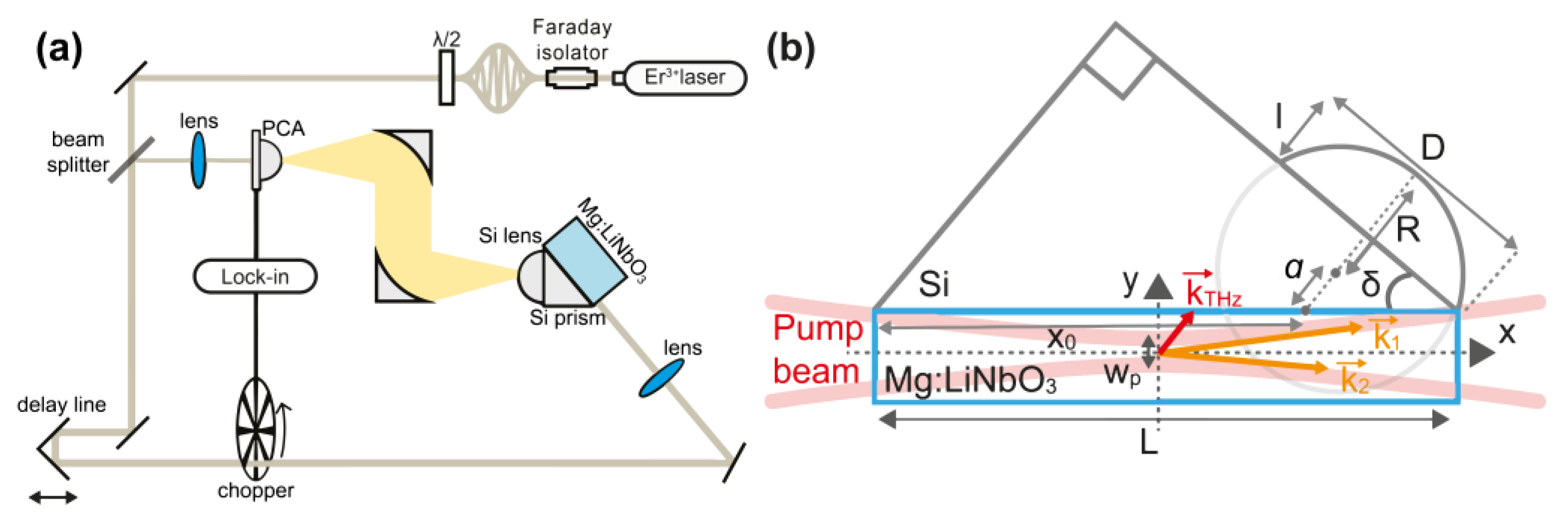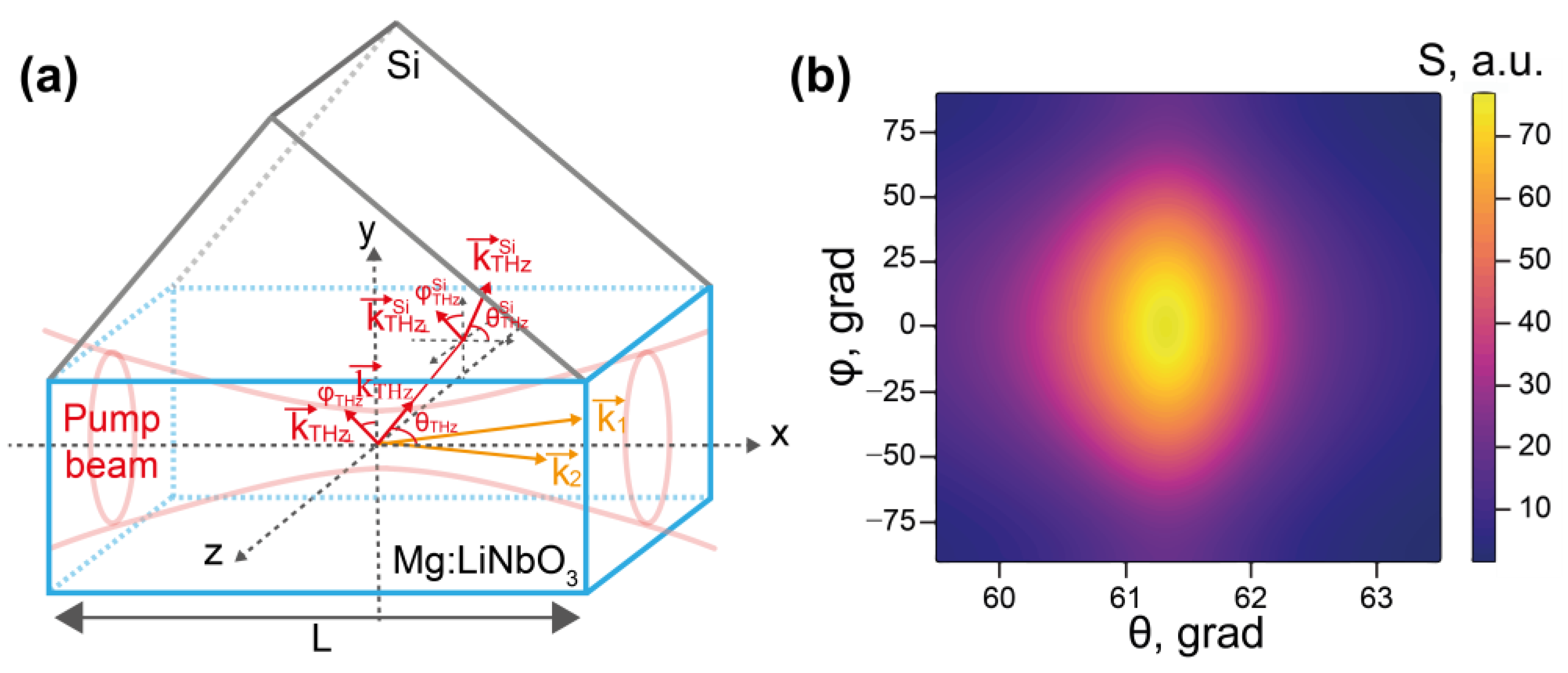An Improvement of the Cherenkov THz Generation Scheme Using Convex Silicon Prism-Lens Adapters
Abstract
:1. Introduction
2. Experimental
3. Theoretical Modeling
4. Discussion
5. Conclusions
Author Contributions
Funding
Institutional Review Board Statement
Informed Consent Statement
Data Availability Statement
Acknowledgments
Conflicts of Interest
References
- Kiwa, T.; Tonouchi, M. Special Issue “Terahertz (THz) Science in Advanced Materials, Devices and Systems”. Photonics 2023, 10, 1024. [Google Scholar] [CrossRef]
- Leitenstorfer, A.; Moskalenko, A.S.; Kampfrath, T.; Kono, J.; Castro-Camus, E.; Peng, K.; Qureshi, N.; Turchinovich, D.; Tanaka, K.; Markelz, A.G.; et al. The 2023 terahertz science and technology roadmap. J. Phys. D Appl. Phys. 2023, 56, 223001. [Google Scholar] [CrossRef]
- Zaytsev, K.I.; Kurlov, V.N.; Skorobogatiy, M.; Reshetov, I.V.; Tuchin, V.V. Special section guest editorial: Advances in terahertz biomedical science and applications. J. Biomed. Opt. 2021, 26, 043001. [Google Scholar] [CrossRef] [PubMed]
- Guo, L.; Deng, C.; Zhao, Y.; Zhang, C. Passive terahertz imaging for security application. In Proceedings of the International Symposium on Photoelectronic Detection and Imaging 2013: Terahertz Technologies and Applications, Beijing, China, 25–27 June 2013; p. 89090S. [Google Scholar] [CrossRef]
- Ellrich, F.; Torosyan, G.; Wohnsiedler, S.; Bachtler, S.; Hachimi, A.; Jonuscheit, J.; Beigang, R.; Platte, F.; Nalpantidis, K.; Sprenger, T.; et al. Chemometric tools for analysing Terahertz fingerprints in a postscanner. In Proceedings of the 2012 37th International Conference on Infrared, Millimeter, and Terahertz Waves, Wollongong, NSW, Australia, 23–28 September 2012; pp. 1–2. [Google Scholar] [CrossRef]
- Shuncong, Z. Progress in terahertz nondestructive testing: A review. Front. Mech. Eng. 2019, 14, 273. [Google Scholar] [CrossRef]
- Neu, J.; Schmuttenmaer, C.A. Tutorial: An introduction to terahertz time domain spectroscopy (THz-TDS). J. Appl. Phys. 2018, 124, 231101. [Google Scholar] [CrossRef]
- Blanchard, F.; Sharma, G.; Razzari, L.; Ropagnol, X.; Bandulet, H.C.; Vidal, F.; Morandotti, R.; Kieffer, J.; Ozaki, T.; Tiedje, H.F.; et al. Generation of Intense Terahertz Radiation via Optical Methods. IEEE J. Sel. Top. Quantum Electron. 2011, 17, 5. [Google Scholar] [CrossRef]
- Bernerd, C.; Segonds, P.; Debray, J.; Roux, J.-F.; Hérault, E.; Coutaz, J.-L.; Shoji, I.; Minamide, H.; Ito, H.; Lupinski, D.; et al. Evaluation of eight nonlinear crystals for phase-matched Terahertz second-order difference-frequency generation at room temperature. Opt. Mater. Express. 2020, 10, 561. [Google Scholar] [CrossRef]
- Huang, W.R.; Huang, S.; Granados, E.; Ravi, K.; Hong, K.; Zapata, L.E.; Kärtner, F.X. Highly efficient terahertz pulse generation by optical rectification in stoichiometric and cryo-cooled congruent lithium niobite. J. Mod. Opt. 2015, 62, 1486. [Google Scholar] [CrossRef]
- Xu, L.; Zhang, X.-C.; Auston, D.H. Terahertz beam generation by femtosecond optical pulses in electro-optic materials. Appl. Phys. Lett. 1992, 61, 1784. [Google Scholar] [CrossRef]
- Lee, Y.-S.; Meade, T.; Perlin, V.; Winful, H.; Norris, T.B.; Galvanauskas, A. Generation of narrow-band terahertz radiation via optical rectification of femtosecond pulses in periodically poled lithium niobate. Appl. Phys. Lett. 2000, 76, 2505. [Google Scholar] [CrossRef]
- L’huillier, J.A.; Torosyan, G.; Theuer, M.; Rau, C.; Avetisyan, Y.; Beigang, R. Generation of THz radiation using bulk, periodically and aperiodically poled lithium niobate—Part 2: Experiments. Appl. Phys. B. 2007, 86, 197. [Google Scholar] [CrossRef]
- Weiss, C.; Torosyan, G.; Meyn, J.-P.; Wallenstein, R.; Beigang, R.; Avetisyan, Y. Tuning characteristics of narrowband THz radiation generated via optical rectification in periodically poled lithium niobate. Opt. Express 2001, 8, 497. [Google Scholar] [CrossRef]
- Hebling, J.; Almási, G.; Kozma, I.Z.; Kuhl, J. Velocity matching by pulse front tilting for large-area THz-pulse generation. Opt. Express 2002, 10, 1161. [Google Scholar] [CrossRef]
- Hirori, H.; Doi, A.; Blanchard, F.; Tanaka, K. Single-cycle terahertz pulses with amplitudes exceeding 1 MV/cm generated by optical rectification in LiNbO3. Appl. Phys. Lett. 2011, 98, 091106. [Google Scholar] [CrossRef]
- Huang, S.-W.; Granados, E.; Huang, W.R.; Hong, K.H.; Zapata, L.; Kärtner, F.X. High conversion efficiency, high energy terahertz pulses by optical rectification in cryogenically cooled lithium niobite. Opt. Lett. 2013, 38, 796. [Google Scholar] [CrossRef]
- Kuznetsov, K.A.; Kitaeva, G.K.; Kovalev, S.P.; Germansky, S.A.; Buryakov, A.M.; Tuchak, A.N.; Penin, A.N. Complex extraordinary dielectric function of Mg-doped lithium niobate crystals at terahertz frequencies. Appl. Phys. B 2016, 122, 223. [Google Scholar] [CrossRef]
- Stepanov, A.G.; Hebling, J.; Kuhl, J. THz generation via optical rectification with ultrashort laser pulse focused to a line. Appl. Phys. B 2005, 81, 23. [Google Scholar] [CrossRef]
- Shikata, J.; Sato, M.; Taniuchi, T.; Ito, H.; Kawase, K. Enhancement of terahertz-wave output from LiNbO3 optical parametric oscillators by cryogenic cooling. Opt. Lett. 1999, 24, 202. [Google Scholar] [CrossRef] [PubMed]
- Suizu, K.; Shibuya, T.; Akiba, T.; Tutui, T.; Otani, C.; Kawase, K. Čherenkov phase-matched monochromatic THz-wave generation using difference frequency generation with a lithium niobate crystal. Opt. Express 2008, 16, 7493. [Google Scholar] [CrossRef] [PubMed]
- Suizu, K.; Koketsu, K.; Shibuya, T.; Tsutsui, T.; Akiba, T.; Kawase, K. Extremely frequency-widened terahertz wave generation using Cherenkov-type radiation. Opt. Express 2009, 17, 6676. [Google Scholar] [CrossRef]
- De Regis, M.; Consolino, L.; Bartalini, S.; De Natale, P. Waveguided Approach for Difference Frequency Generation of Broadly-Tunable Continuous-Wave Terahertz Radiation. Appl. Sci. 2018, 8, 2374. [Google Scholar] [CrossRef]
- Minamide, H.; Hayashi, S.; Nawata, K.; Taira, T.; Shikata, J.; Kawase, K. Kilowatt-peak Terahertz-wave Generation and Sub-femtojoule Terahertz-wave Pulse Detection Based on Nonlinear Optical Wavelength-conversion at Room Temperature. J. Infrared Millim. Terahertz Waves 2014, 35, 25. [Google Scholar] [CrossRef]
- Bakunov, M.I.; Mashkovich, E.A.; Tsarev, M.V.; Gorelov, S.D. Efficient Cherenkov-type terahertz generation in Si-prism-LiNbO3-slab structure pumped by nanojoule-level ultrashort laser pulses. Appl. Phys. Lett. 2012, 101, 151102. [Google Scholar] [CrossRef]
- Bodrov, S.B.; Bakunov, M.I.; Hangyo, M. Efficient Cherenkov emission of broadband terahertz radiation from an ultrashort laser pulse in a sandwich structure with nonlinear core. J. Appl. Phys. 2008, 104, 093105. [Google Scholar] [CrossRef]
- Takeya, K.; Minami, T.; Okano, H.; Tripathi, S.R.; Kawase, K. Enhanced Cherenkov phase matching terahertz wave generation via a magnesium oxide doped lithium niobate ridged waveguide crystal. APL Photonics 2017, 2, 016102. [Google Scholar] [CrossRef]
- Fan, S.; Takeuchi, H.; Ouchi, T.; Takeya, K.; Kawase, K. Broadband terahertz wave generation from a MgO:LiNbO3 ridge waveguide pumped by a 1.5 μm femtosecond fiber laser. Opt. Lett. 2013, 38, 1654–1656. [Google Scholar] [CrossRef] [PubMed]
- Takeya, K.; Suizu, K.; Sai, H.; Ouchi, T.; Kawase, K. Wide Spectrum Terahertz-Wave Generation From Nonlinear Waveguides. IEEE J. Sel. Top. Quantum Electron. 2013, 19, 8500212. [Google Scholar] [CrossRef]
- Bakunov, M.I.; Bodrov, S.B. Si–LiNbO3–air–metal structure for concentrated terahertz emission from ultrashort laser pulses. Appl. Phys. B 2010, 98, 1–4. [Google Scholar] [CrossRef]
- Sychugin, S.A.; Mashkovich, E.A.; Maslov, A.V.; Bakunov, M.I. Terahertz Cherenkov radiation from a tightly focused ultrashort laser pulse in an electro-optic medium. J. Opt. Soc. Am. B 2019, 36, 1101–1107. [Google Scholar] [CrossRef]
- Kitaeva, G.K.; Markov, D.A.; Safronenkov, D.A.; Starkova, N.V. Prism Couplers with Convex Output Surfaces for Nonlinear Cherenkov Terahertz Generation. Photonics 2023, 10, 450. [Google Scholar] [CrossRef]
- Novikova, T.I.; Kuznetsov, K.A.; Leontyev, A.A.; Kitaeva, G.K. Quantum and classical contributions to spontaneous scattering by terahertz phonon polaritons at cryogenic temperatures. In Proceedings of the 2019 44th International Conference on Infrared, Millimeter, and Terahertz Waves (IRMMW-THz), Paris, France, 1–6 September 2019. [Google Scholar] [CrossRef]
- Kitaeva, G.K.; Kuznetsov, K.A.; Naumova, I.I.; Penin, A.N. Influence of structural defects on the optical properties of Mg:LiNbO3 single crystals. Quantum. Electron. 2000, 30, 726–732. [Google Scholar] [CrossRef]
- Prudkovskii, P.A. Correlation Properties of an Optical–Terahertz Biphoton Field. JETP Lett. 2021, 114, 173–179. [Google Scholar] [CrossRef]




| Lens # | Curvature Radius R, mm | Diameter D, mm | Thickness l, mm |
|---|---|---|---|
| 1 | 6.0 | 10.4 | 3.0 |
| 2 | 6.0 | 11.5 | 4.3 |
| 3 | 5.0 | 10.0 | 6.3 |
| Experimental Set-Up | P, a.u. Numerical Results | P, a.u. Experimental Results | ||
|---|---|---|---|---|
| 0.5 THz | 1.0 THz | 0.5 THz | 1.0 THz | |
| prism | 1 | 1 | 1 | 1 |
| prism + lens #1 | 25 | 22 | 12 | 6 |
| prism + lens #2 | 50 | 60 | 10 | 9 |
| prism + lens #3 | 2 | 2 | 7 | 3 |
Disclaimer/Publisher’s Note: The statements, opinions and data contained in all publications are solely those of the individual author(s) and contributor(s) and not of MDPI and/or the editor(s). MDPI and/or the editor(s) disclaim responsibility for any injury to people or property resulting from any ideas, methods, instructions or products referred to in the content. |
© 2023 by the authors. Licensee MDPI, Basel, Switzerland. This article is an open access article distributed under the terms and conditions of the Creative Commons Attribution (CC BY) license (https://creativecommons.org/licenses/by/4.0/).
Share and Cite
Kitaeva, G.K.; Safronenkov, D.A.; Starkova, N.V. An Improvement of the Cherenkov THz Generation Scheme Using Convex Silicon Prism-Lens Adapters. Photonics 2023, 10, 1145. https://doi.org/10.3390/photonics10101145
Kitaeva GK, Safronenkov DA, Starkova NV. An Improvement of the Cherenkov THz Generation Scheme Using Convex Silicon Prism-Lens Adapters. Photonics. 2023; 10(10):1145. https://doi.org/10.3390/photonics10101145
Chicago/Turabian StyleKitaeva, Galiya Kh., Daniil A. Safronenkov, and Natalia V. Starkova. 2023. "An Improvement of the Cherenkov THz Generation Scheme Using Convex Silicon Prism-Lens Adapters" Photonics 10, no. 10: 1145. https://doi.org/10.3390/photonics10101145





